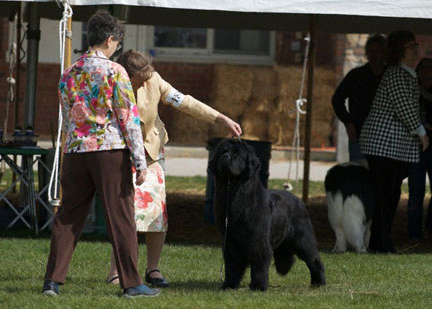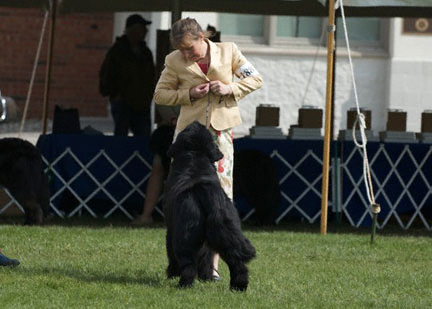Newfoundland Coat Care for the Conformation or Obedience Ring by Pauline Baldwin
 When Ingrid asked me to write a grooming article for NewfTide, I kind of laughed, as I am more like a "part time" show person, I spend most of my time at obedience trials. However, I do like our dogs to look like the breed entrants-they are not "they'll do, its only obedience!" So, for all of you "part time" show people, here goes.
When Ingrid asked me to write a grooming article for NewfTide, I kind of laughed, as I am more like a "part time" show person, I spend most of my time at obedience trials. However, I do like our dogs to look like the breed entrants-they are not "they'll do, its only obedience!" So, for all of you "part time" show people, here goes.
I live in a very dry climate and find it difficult to keep a huge full coat on my dogs at any time of the year. In the summer, my Newfs are in the (smelly) river every day. I do not bathe them every week, as it would be a lost cause! However, I do bathe them before every show or trial.
Every week, if actively showing, or about two months before the National, I will start getting them prepared. I use a pin brush and thoroughly brush my Newfoundlands out at least three times a week. On the alternate days I spray them with water and blow out all of the dust and dander. This is a good time to check the skin, to see that it is looking healthy. I usually have to comb through feathers to get our anything that is attached from their walks; for the most part I do this every day. Our dogs are walked every day and tend to bring home all kinds of debris in their coats!
 On the week of the show I will start with a complete comb out, right down to the skin. I mist them thoroughly with a conditioner to stop the coat from breaking while being combed. I use one part (tablespoon) Cindra Moisturizer and two parts Reconstuctor, mixed with warm water in the summer. The reverse is used in the winter, as it tends to be a dryer season here. I use a product called Motions all year, an oil sheen and conditioning spray, on all the feathering, pants and tail to stop them going brown or brittle. I spray into the feathers after I have combed them out, then comb from the skin to the tips of the hair, making sure it gets fully covered. I do not use on the back of the dog, as I find there are enough natural oils there to keep the hair healthy.
On the week of the show I will start with a complete comb out, right down to the skin. I mist them thoroughly with a conditioner to stop the coat from breaking while being combed. I use one part (tablespoon) Cindra Moisturizer and two parts Reconstuctor, mixed with warm water in the summer. The reverse is used in the winter, as it tends to be a dryer season here. I use a product called Motions all year, an oil sheen and conditioning spray, on all the feathering, pants and tail to stop them going brown or brittle. I spray into the feathers after I have combed them out, then comb from the skin to the tips of the hair, making sure it gets fully covered. I do not use on the back of the dog, as I find there are enough natural oils there to keep the hair healthy.
When the dog is completely combed out, I trim our all the excess hair from under their feet and tidy up around and under the ears. Nails are clipped, and then they get bathed. I use a good quality shampoo, BioGroom Protein and Lanolin. I find that it cleans the dog but does not strip out their natural oils. I sometimes use a conditioner Bio Groom Silk creme rinse, which I massage into the feathers, tail and pants. The next job is to get them dry.
Most Newfoundlands have fairly straight coats, which makes them easy to dry. However, I have a Newfoundland that has a less than perfect coat and takes extra time in the drying. I start by blowing out the excess water. I then concentrate on the back, starting at the tail and work towards the neck, blowing toward the tail at all times. To help the coat lay straight and "stay" straight I use Cindra Super Coat mixed with two-thirds water in a spray bottle, which I spray on to the coat as I blow-dry. I blow-dry the back of the dog till I think it is dry, then I blow-dry twenty more minutes, just to be sure it is thoroughly dry! I will put a thick, heavy towel on the back end of the dog to keep the coat from getting wet or blowing forward while I dry off the rest of the coat.
Now the dog is completely dry. To trim, or not to trim? Well, I trim! I cannot stand a dog that is moving toward me and excess hair is flapping all over the place. I watch the dog move and take off any hair that is spoiling the appearance of the dog coming and going. Of course, I also trim the usual, feet and ears. I will tidy up the neck area, under the chin and chest, the sides of the front feathers and shorten up the hock hair to match the pants. I pay attention to the balance of the dog and trim accordingly.
On the day of the show, it all starts again! I brush out the body and comb out the feathering, using the conditioning spray, then, subject to availability, I will bathe all over again and repeat the drying process. If there is no bathing facility, I will spray down the dog till it is wet throughout, then dry. Depending on where I am showing, I will spray the dog down with different liquids. In a dry climate I will use plain old water, maybe with a little moisturizer. If in a humid climate I would use a mixture of Listerine and water, this helps the coat stay "fluffed" up.
Just before we go to ring side I will use the blower to make sure the dog is thoroughly dry and to give that final poofing. I then check again, to see if any bits of hair are sticking up or going in the wrong direction and trim off. I am now ready to take my beautiful Newfoundland to the show or obedience ring!
reprinted from NewfTide 2002, Images © Chad Perry 2009, used with permission